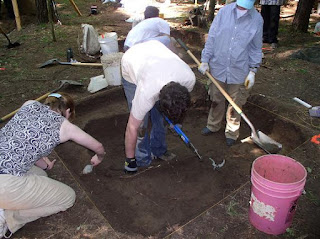Working in the Block 1 Area
To get a better idea of the site boundaries and the locations of the most intense areas of prehistoric activity, we are excavating 30 cm round shovel tests across the site along a 10 m grid. This week, the shovel tests revealed two new areas of interest at the site. In one test, the base of an Archaic projectile point and lithic debitage were recovered from approximately 40 centimeters below surface (cmbs). This area is northeast of the Block 1 area, closer to the edge of the terrace, where the flat landform drops off into a slough that parallels the Mountain Fork River. A 2 x 2 m test unit was started in this location. We recovered decorated Caddo sherds and a projectile point from the upper levels and hope to encounter some undisturbed Archaic artifacts in the soil stratum below the late prehistoric component. Shovel testing will continue next week.
Patrick Livingood has been training students on how to use the total station for surveying while also creating a contour map of the approximately 30 acres that make up the site as well as the surrounding area. The pine trees and undergrowth have posed somewhat of a challenge, but they have allowed the students plenty of practice in creating upwards of 30 survey stations. While everyone enjoys the long weekend, we'll be looking forward to see what we find next week!
Amanda Regnier
Oklahoma Archeological Survey

















